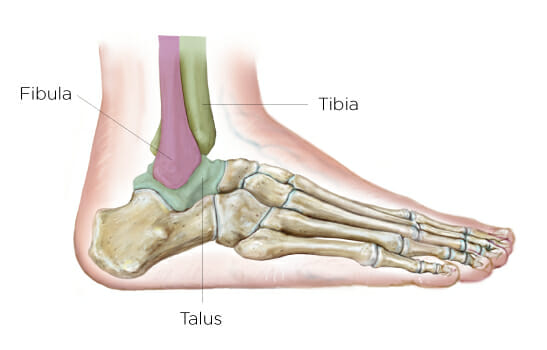Ankle Arthroscopy

What is Ankle Arthroscopy?
Arthroscopy of the ankle is a minimally invasive surgery that allows the surgeon to look inside the ankle joint and treat various conditions. Two small incisions are made on the front of the ankle. A small camera and instruments are used to “clean up” the ankle.
What can I expect after surgery?
- Weight-Bearing: You will put weight on the affected foot as tolerated after surgery.
- Physical Therapy: You do not require physical therapy after this surgery.
- Immobilization: You will be placed into a CAM boot that only needs to be worn for comfort. A CAM boot supports the foot and ankle and provides protection after surgery.
What is the typical follow-up appointment schedule after surgery?
- Two Weeks: The stitches are removed. If the patient has not weaned out of the CAM boot, this program is also started.
- Six Weeks: Progress is evaluated.
- Three Months: Progress is evaluated.
Microfracture of an osteochondral lesion
What is an osteochondral lesion?
Osteochondral lesions are injuries to the talus (the bottom bone of the ankle joint) or tibia (the top bone of the ankle joint) that involve both the bone and the overlying cartilage. These injuries may include blistering of the cartilage layers, cyst-like lesions within the bone underlying the cartilage, or fracture of the cartilage and bone layers.
What is a microfracture?
Arthroscopic operative instruments are inserted into the joint to clean out the cyst
and create bleeding in the cyst to promote new cartilage growth.
What can I expect after surgery?
- Weight-Bearing: Your surgeon will determine how long you need to stay off your ankle, but likely 2 to 6 weeks of non-weight-bearing will be prescribed to allow for cartilage regrowth.
- Physical Therapy: You will start a physical therapy program 6 weeks after surgery.
- Immobilization: You will be placed into a CAM boot that is worn for 6 weeks. A CAM boot supports the foot and ankle and provides protection after surgery.
What is the typical follow-up schedule?
- Two Weeks: The stitches are removed. No X-rays are needed. At this point, the patient can start putting weight on the affected leg
in the CAM boot.
- Six Weeks: You will be weaned out of the CAM boot and physical therapy is started.
- Three Months: Progress is evaluated.
Ankle arthrodesis
What is Ankle Arthritis?
Ankle arthritis occurs when there has been damage to the joint cartilage that normally covers and protects the bones. This results in pain, stiffness, and swelling of the ankle. It is usually caused by from an injury to the ankle.
What is Ankle Arthrodesis?
An ankle arthrodesis is a reconstructive surgical procedure where an arthritic ankle joint is converted into an immobile segment of bone. The ankle consists of the distal tibia (shin bone), talus (small bone between the heel bone, tibia, and fibula), and fibula (smaller leg bone paired with the tibia). The motion between these bones is essentially eliminated in an ankle fusion.
What can I expect after surgery?
- Weight-Bearing: You will not put weight on the affected leg for 6 to 8 weeks after surgery (non-weight-bearing).
- Physical Therapy: You will start physical therapy 6 to 8 weeks after surgery.
- Immobilization: You will be placed into a bulky Jones splint, a soft splint bandage to compress, limit movement, and protect the area after surgery.
What is the typical follow-up schedule?
- Two Weeks: The bulky Jones splint is removed, stitches are removed, and X-rays are completed. The patient is placed into a CAM boot. A CAM boot supports the foot and ankle and provides protection after surgery.
- Six Weeks: X-rays are completed and the fusion is evaluated to determine weight-bearing status. If everything looks good, a progressive weight-bearing program is started, which includes transitioning into a normal shoe.
- Three Months: X-rays are completed.
Total ankle replacement
What is A total ankle replacement?
Replacing the ankle joint as a means of treating arthritis is a more contemporary procedure—one that avoids having to fuse the joint. Using a jig, your specialist cuts the bones and secures plastic and metal components in such a way that the ankle joint can move naturally. Pain relief and preservation of ankle motion are expected outcomes of this course of action.
What can I expect after surgery?
- Weight-Bearing: You will not put weight on the affected leg for 6 to 8 weeks after surgery (non-weight-bearing).
- Physical Therapy: You will start physical therapy 6 to 8 weeks after surgery.
- Immobilization: You will be placed into a bulky Jones splint, a soft splint bandage to compress, limit movement, and protect the area after surgery.
What is the typical follow-up schedule?
- Two Weeks: The bulky Jones splint is removed, stitches are removed, and X-rays are completed. The patient is placed into a CAM boot. A CAM boot supports the foot and ankle and provides protection after surgery.
- Six Weeks: X-rays are completed and the joint is evaluated to determine weight-bearing status. If everything looks good, a progressive weight-bearing program is started, which includes transitioning into a normal shoe.
- Three Months: X-rays are completed.
